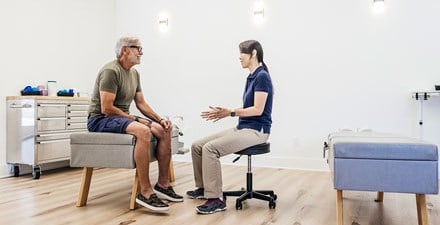
Sales of prescribed opioids have quadrupled in the United States. This has happened even though "there has not been an overall change in the amount of pain that Americans report." (Centers for Disease Control & Prevention)
In response an opioid epidemic, the CDC released opioid prescription guidelines in March 2016. The guidelines recognize that prescribed opioids are appropriate in certain cases, including:
- Cancer treatment.
- Palliative care.
- End-of-life care.
- Certain acute care situations (such as after surgery), if properly dosed.
But for other pain management, the CDC recommends nonopioid approaches including physical therapy. The following are some reasons why you should choose physical therapy instead of prescribed opioids for pain.
Choose physical therapy when:
- The risks of taking opioids outweigh the rewards.
Potential side effects of opioids include:- Depression.
- Overdose.
- Addiction.
- Withdrawal symptoms when stopping use.
Because of these risks, "experts agree that opioids should not be used as firstline or routine therapy for chronic pain," the CDC guidelines state. Even in cases with limited evidence on the long-term benefits of non-opioid therapies, "risks are much lower" with non-opioid treatment.
- You want to do more than mask the pain.
Opioids reduce the feeling of pain by disrupting pain signals to the brain. Physical therapists treat pain through movement. They partner with patients to improve or maintain their mobility and quality of life. - Your pain or function problems are linked to low back pain, hip or knee osteoarthritis, or fibromyalgia.
High-quality evidence supports exercise as part of a physical therapy treatment plan for these conditions. - Even when your doctor prescribes you opioids for pain.
Even when opioids are prescribed, the CDC recommends that patients should receive "the lowest effective dosage." It also says that opioids "should be combined" with nonopioid therapies, such as physical therapy. - Your pain lasts 90 days or more.
After 90 days pain is considered "chronic." The risks from continued opioid use increase. An estimated 116 million Americans have chronic pain each year. The CDC guidelines note that nonopioid therapies are "preferred" for chronic pain. They also say that physicians should only consider opioid therapy if the expected benefits for pain and function outweigh risks.
Before taking opioids, consult with a physical therapist to discuss options for safer treatment.
"Patient education and discussion before starting opioid therapy are critical so that patient preferences and values can be understood and used to inform clinical decisions," the CDC states.
Physical therapists can play a valuable role in the patient education process. They help people set realistic expectations for recovery with or without opioids.
Physical therapists are movement experts. They improve quality of life through hands-on care, patient education, and prescribed movement. You can contact a physical therapist directly for an evaluation. To find a physical therapist in your area, visit Find a PT.
Related Resources
- Health Center on Opioid Use for Pain Management
- CDC Recommends Physical Therapy and Other Nondrug Options for Chronic Pain
- Using Opioids for More Than 30 Days Could Increase Depression Risk
- Widespread Pain is Creating Widespread Prescription Drug Use
- Health Center on Pain
The American Physical Therapy Association raises awareness about the risks of opioids and the safe alternative of physical therapy for long-term pain management. Learn more at our safe pain management page.


